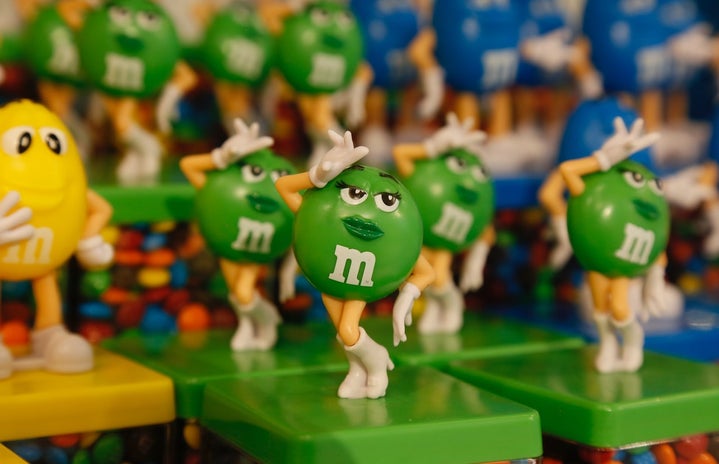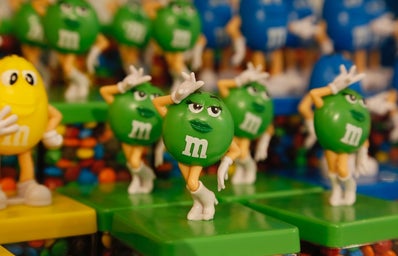Any of you who have had the misfortune of knowing me personally knows that I always have something to say for just about anything. Unless it’s math or sports. I suck at those. But nonetheless, it’s been a minute since I got on my internet soapbox, so we’re going to talk about something that, at the time of posting, was relevant like 2 months ago: The Green M&M.
Did I, at any point in my 19 years of living and complaining about things, think that the M&Ms would be a topic of conversation? No. Not in the slightest. The only time M&Ms are ever a topic of interest to me is when I go to the grocery store and buy the M&M Minis that are right by the cash register. Say what you want, but those hit different.
So why are we here? Why am I sitting here, hunched over, writing about pieces of chocolate candy and their anthropomorphic counterparts? Why are you here, reading about it?
All hell broke loose on Twitter (as it usually does) in late January when Mars Wrigley, the company that produces M&Ms, announced that the M&M characters would be getting rebranded to be more inclusive. And look, I’m all for representation and inclusivity in media and marketing, but the question had to be asked: How do you rebrand 6 pieces of anthropomorphic chocolate to be inclusive?
Well, no need to wonder! Mars answered that for us by changing the shoes of the Green and Brown M&Ms, who are both female characters. The Brown M&M had her high heels traded in for kitten heels, and the Green M&M’s iconic go-go boots were traded in for a pair of sneakers, which the internet has collectively decided is ugly. There were also changes to the male M&M’s character archetypes, but to quote EJ Dickson for Rolling Stone’s wonderful article about the same matter: “The distinction is pretty negligible for the male characters…frankly they are men, and thus I don’t really care.”
Absolutely no one was complaining about the M&M.
At least, no one that the general public knows of. And I know, the most obvious thought comes to mind: Is this really the hill you’re going to die on?
Well, not exactly. I’m dying on a much bigger hill here.
My issue, despite the Green M&Ms shoes being absolutely horrendous at this point, has little to do with M&Ms in itself. Rather, Mars’ recent rebranding of them is the most recent example of a bigger problem: Corporations and their struggles to rebrand themselves inclusively.
Now look, rebranding isn’t a new phenomenon. It’s a crucial point of maintaining survival for most businesses and brands, and they usually do it to keep up with the changing times, or…if they’ve suffered some major scandal…to separate themselves from whatever that was. If you need an example of the former, Target has been remodeling many of their locations by adjusting layouts and adding “modern” light fixtures and flooring, and considering its popularity in recent years, they are likely going for a more ‘minimalistic’ look. Select Targets now include Ulta Beauty products, and while this is more-so a business partnership instead of a rebrand, it definitely assists in doing so for both companies.
And if you need an example of the latter, remember how when Frances Haugen, a Facebook whistleblower, testified to Congress that The Facebook Company and its platforms were harmful, knew of this, and did nothing to stop it, the company suddenly changed its name to Meta? Yeah. Legal trouble almost always means rebrand, especially on this grand of a scale.
What has been more recent in rebranding is inclusivity, which is the overall purpose of why the M&Ms are being redesigned. Again, either because brands want to keep up with demand for proper representation, or because something about their branding was offensive or connected to discriminatory scandal, and the company wants to show that they care about all of their customers, notably the ones affected in said incident. An example of Reason #1 Rihanna’s Savage X Fenty brand, whose online photos and fashion shows include models of different gender identities, races, and body shapes and sizes, just to name a few. A more widely-known example is Old Navy’s shift to Body-Inclusivity in their stores.
So what exactly went wrong here, besides the fact that it’s extremely hard to be inclusive with pieces of candy?
Like I said earlier, no one was complaining about the M&Ms footwear! Granted, it should not have to take people complaining about offensive imagery or lack of representation for inclusive rebranding to occur, but when it does happen, companies need feedback from whoever they’re striving to include. In this case, I’m not quite sure who we’re trying to include in the M&Ms, because once again, they’re M&Ms and are not real, but Mars apparently said it was trying to aim itself towards Gen Z? I sincerely believe that they’ve spoken to someone born between 1997-2010, because if they had, they’d know we have bigger fish to fry than worrying about the shoe choices of the M&Ms.
Oh, and they clearly missed the fact that platform boots are a fashion trend with this generation. After all, I’ve got some off-white go-go boots in my closet.
We’re in a critical time for the economy, and the buzzword right now is inflation. Prices are high, wages are low, and people are angry; if corporations want to stay afloat by showing that different demographics are included in their target market and are “just like them”, shoe changes won’t suffice. Make conversation and make the changes to ensure that inclusivity will be material instead of monetary.


